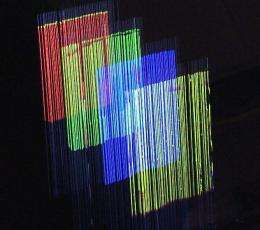A Multi-Layered Display with Water Drops (w/ Video)

(PhysOrg.com) -- AquaLux 3D, a new projection technology developed at Carnegie Mellon University's Robotics Institute, can target light onto and between individual water droplets, enabling text, video and other moving or still images to be displayed on multiple layers of falling water.
In contrast to existing technologies for projecting images onto water surfaces, AquaLux 3D makes it possible to create three-dimensional images in water by using multiple layers of precisely controlled water droplets, said Srinivasa Narasimhan, associate professor of robotics. By combining the droplets with clouds of mist, it would be possible to create unique 3-D effects for theme parks, exhibitions and interactive games that don't require special eyeglasses to view, he added.
"The beauty of water drops is that they refract most incident light, so they serve as excellent wide-angle lenses that can be among the brightest elements of an environment," said Narasimhan, who developed the display with Takeo Kanade, professor of computer science and robotics, and Peter Barnum, a Ph.D. student in robotics. "By carefully generating several layers of drops so that no two drops occupy the same line-of-sight from the projector, we can use each drop as a voxel that can be illuminated to create a 3-D image."
The researchers will discuss AquaLux 3D July 27 at SIGGRAPH, the 37th International Conference and Exhibition on Computer Graphics and Interactive Techniques, in Los Angeles.
Narasimhan said work on the display technology was an outgrowth of efforts to develop an LED automobile headlight system for driving in rain at night. To eliminate the headlight reflection that can make it difficult for drivers to see in rainy conditions, they explored ways to control light so that as many rays as possible would shine between raindrops. "What we realized is that it was much easier to shine light on the drops themselves," he said.
To create a multi-dimensional display using water drops, Narasimhan, Kanade and Barnum needed to be able to target individual drops and to direct light between drops so that multiple layers of drops could be illuminated. So they developed a tightly coupled system that enabled them to generate rows of drops by using computer-controlled manifolds. By synchronizing the timing of drop generation between the rows, they ensured that drops in the front rows did not block the drops in the back rows. A camera tracks the positions of the drops, so a projector can independently target each row of drops.

The system can generate drops at the rate of 60 per second, though a rate of 10 per second is sufficient for the human eye to perceive continuous resolution in each column of drops; increasing the number of drops per second increases the brightness of the display. The Carnegie Mellon researchers have demonstrated the display with four linear layers of drops and a single projector, but Narasimhan said there is no limit to the number of layers and projectors that could be employed and that the drops could be arrayed in patterns other than linear rows.
The researchers have used the water drops to display video images, text, a simulation of fish swimming in an aquarium, alternating sheets of solid colors and even a multi-dimensional version of the video game Tetris.
"One unique aspect of AquaLux 3D is the potential for physical interaction," Narasimhan said. "People can touch the water drops and alter the appearance of images, which could lead to interactive experiences we can't begin to predict. We look forward to the day when creative people can fully explore the potential of this display."
More information: www.cs.cmu.edu/~ILIM/projects/ … rDisplay2/index.html
Provided by Carnegie Mellon University


















